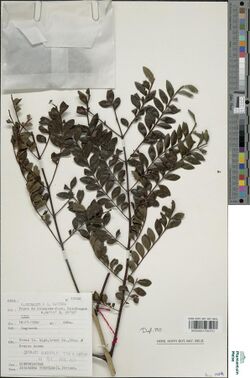Biology:Jacaranda caerulea
| Jacaranda caerulea | |
|---|---|

| |
| Scientific classification | |
| Kingdom: | Plantae |
| Clade: | Tracheophytes |
| Clade: | Angiosperms |
| Clade: | Eudicots |
| Clade: | Asterids |
| Order: | Lamiales |
| Family: | Bignoniaceae |
| Genus: | Jacaranda |
| Species: | J. caerulea
|
| Binomial name | |
| Jacaranda caerulea (L.) J. St.-Hil.
| |
Jacaranda caerulea (boxwood or cancertree) is a flowering tree belonging to the genus Jacaranda. It is native to the West Indies, in Cuba, Hispaniola (the Dominican Republic and Haiti) and the Bahamas.[2][3]
Description
Jacaranda caerula was described in 1805 by French naturalist Jean Henri Jaume Saint-Hilaire.[4] It grows up to 12 metres (39 ft) in height and has 40 cm long, bipinnate leaves each with 8 to 26 pinna.[5]
The flowers are purplish blue in colour with a tubular shape, being narrower towards the base and larger at the tip. They measure 3.5 to 4 cm long and 1 to 1.4 cm wide at the mouth.[5] It flowers intermittently throughout spring and summer, rather than having one big bloom during spring.[3]
Distribution
The tree is native to the Bahamas, Hispaniola, and Cuba, but can also be found in Florida where it was introduced for landscaping purposes.[3] It most commonly found in limestone areas between sea level and 300m.[5]
Uses
The leaves are used in some places for their antiseptic properties. In the Bahamas, decoctions are made from the dried leaves and used as an alternative treatment for a variety of skin complaints, including skin cancer. In Cuba, decoctions of leafy branches are used to treat eczema and acne.[6]
References
- ↑ Freid, E.H.; Timyan, J. (2022). "Jacaranda caerulea". IUCN Red List of Threatened Species 2022: e.T202826219A202880978. doi:10.2305/IUCN.UK.2022-1.RLTS.T202826219A202880978.en. https://www.iucnredlist.org/species/202826219/202880978. Retrieved 24 July 2022.
- ↑ Grandtner, M.M. (2005). Elsevier's Dictionary of Trees: Volume 1: North America. p. 451. ISBN 9780080460185.
- ↑ 3.0 3.1 3.2 Popenoe, John (1980). "Bahamian Trees for the South Florida Landscape". Proc. Fla. StateHort. Soc. 93: 86–87. http://fshs.org/proceedings-o/1980-vol-93/86-87%20(POPENOE).pdf.
- ↑ "Publication Details, Exposition des Familles Naturelles...Paris (chez Treuttel et Würtz, ...), Strasbourg (meme Maison de Commerce)". International Plant Names Index. http://www.ipni.org/ipni/idPublicationSearch.do;jsessionid=831EA72159875E6C71CA1C4234C7D1E1?back_page=&id=6341-2.
- ↑ 5.0 5.1 5.2 Gentry, Alwyn H. (1992-04-13). "Organization for Flora Neotropica, Bignoniaceae: Part II (Tribe Tecomeae)". Flora Neotropica (New York Botanical Garden Press) 25 (2): 62.
- ↑ Duke, James A. (2008). Duke's Handbook of Medicinal Plants of Latin America. CRC Press. p. 381. ISBN 9781420043174.
Wikidata ☰ Q15550475 entry
 |


